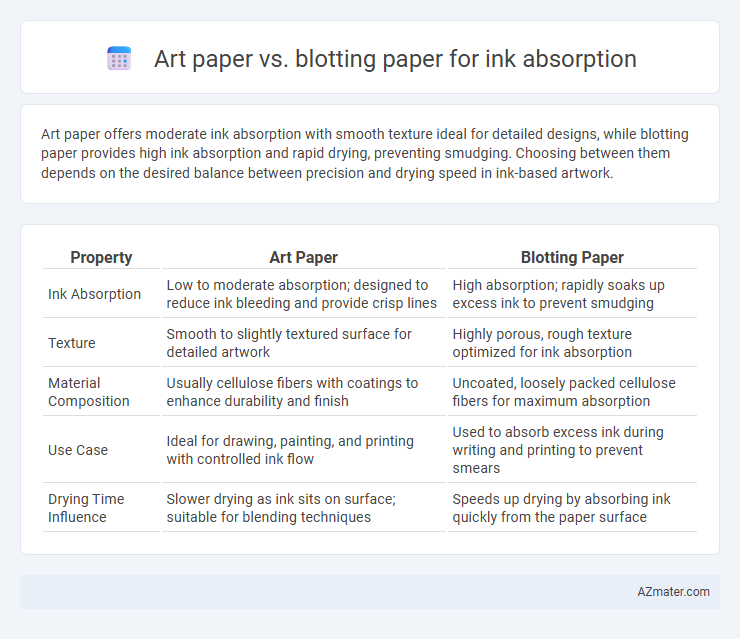Art paper offers moderate ink absorption with smooth texture ideal for detailed designs, while blotting paper provides high ink absorption and rapid drying, preventing smudging. Choosing between them depends on the desired balance between precision and drying speed in ink-based artwork.
Table of Comparison
| Property | Art Paper | Blotting Paper |
|---|---|---|
| Ink Absorption | Low to moderate absorption; designed to reduce ink bleeding and provide crisp lines | High absorption; rapidly soaks up excess ink to prevent smudging |
| Texture | Smooth to slightly textured surface for detailed artwork | Highly porous, rough texture optimized for ink absorption |
| Material Composition | Usually cellulose fibers with coatings to enhance durability and finish | Uncoated, loosely packed cellulose fibers for maximum absorption |
| Use Case | Ideal for drawing, painting, and printing with controlled ink flow | Used to absorb excess ink during writing and printing to prevent smears |
| Drying Time Influence | Slower drying as ink sits on surface; suitable for blending techniques | Speeds up drying by absorbing ink quickly from the paper surface |
Understanding Art Paper and Blotting Paper
Art paper features a smooth, coated surface designed to enhance ink vibrancy and detail retention, making it ideal for fine art and illustration work. Blotting paper is highly absorbent and porous, specifically engineered to quickly soak up excess ink and prevent smudging during writing or calligraphy. Understanding the distinct properties of art paper and blotting paper helps artists and writers choose the right medium for either precision or ink control.
Composition and Manufacturing Differences
Art paper typically consists of cellulose fibers with a smooth or textured surface designed to balance ink absorption and durability, often treated with coatings like clay or chalk to control ink spread. Blotting paper is made from highly absorbent, loosely woven cellulose fibers, manufactured without coatings to maximize ink absorption by drawing moisture away quickly. The manufacturing process of blotting paper emphasizes porosity and thickness to enhance capillary action, while art paper's production focuses on surface finish and fiber bonding to support detailed ink application.
Surface Texture Comparison
Art paper features a smooth, tightly woven surface that allows ink to sit on top, creating sharp lines and vibrant colors. Blotting paper has a porous, rough texture designed specifically for rapid ink absorption, preventing smudges by quickly drawing excess ink into its fibers. The contrast in surface texture directly influences ink behavior, with art paper promoting precision and blotting paper enhancing drying efficiency.
Ink Absorption Properties
Art paper offers moderate ink absorption, balancing surface smoothness and ink retention to enhance color vibrancy and detail clarity in various art mediums. Blotting paper features high absorbency with a porous texture designed to quickly soak up excess ink, preventing smudging and providing rapid drying. Ink absorption on blotting paper results in minimal ink spread, while art paper allows controlled absorption for precise artwork and sharper lines.
Impact on Ink Drying Time
Art paper typically has a smoother surface with a coated finish that slows ink absorption, resulting in extended ink drying times compared to blotting paper. Blotting paper, designed with a porous and highly absorbent texture, rapidly pulls ink from the surface, significantly reducing drying time and preventing smudging. The choice between art paper and blotting paper directly affects the efficiency of ink drying, with blotting paper offering superior performance in quick ink absorption.
Applications in Art and Calligraphy
Art paper offers smooth texture and archival quality ideal for detailed ink work and vibrant color retention in fine art and calligraphy. Blotting paper excels at rapid ink absorption, preventing smudges and enabling quick drying, which is essential for fast-paced writing and ink layering techniques. Artists and calligraphers select art paper for precision and finish, while blotting paper serves as a practical tool to control excess ink and maintain clean lines.
Pros and Cons for Artists
Art paper offers a smooth texture and vibrant ink retention, enhancing color depth but may cause ink to sit on the surface, leading to longer drying times and potential smudging. Blotting paper excels in rapid ink absorption, preventing smears and enabling clean layering, yet its rough texture can distort fine details and dull color vibrancy. Artists seeking precision and vivid colors often favor art paper, while those prioritizing fast drying and minimal smudging might prefer blotting paper.
Longevity and Archival Quality
Art paper offers superior longevity and archival quality compared to blotting paper, as it is specially manufactured using acid-free fibers that resist yellowing and deterioration over time. Blotting paper, designed primarily for rapid ink absorption, lacks the durability and chemical stability needed for long-term preservation, making it unsuitable for archival purposes. For artworks and documents requiring long-lasting ink retention and minimal fading, high-quality art paper provides optimal performance and durability.
Price and Availability Differences
Art paper typically costs more than blotting paper due to its higher quality and specialized texture designed for smooth ink application, whereas blotting paper is generally cheaper and widely available in stationery stores and online. Blotting paper excels at ink absorption and drying, making it ideal for preventing smudges in calligraphy and fountain pen use, while art paper favors detailed artwork and ink retention with less absorption. Availability of blotting paper is consistent in bulk formats, whereas art paper comes in various grades and sizes, affecting both price and purchase options for different artistic needs.
Choosing the Right Paper for Your Needs
Art paper features a smooth surface designed for detailed ink work, absorbing ink evenly to prevent smudging while maintaining color vibrancy. Blotting paper excels at rapid ink absorption, quickly drying excess ink to avoid smears but may cause feathering with fine lines. Choosing the right paper depends on your project's precision needs and drying time, where art paper suits detailed artwork, and blotting paper is ideal for managing wet ink during writing or control.

Infographic: Art paper vs Blotting paper for Ink absorption
 azmater.com
azmater.com